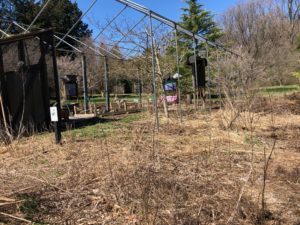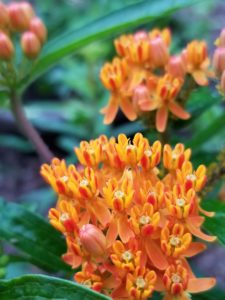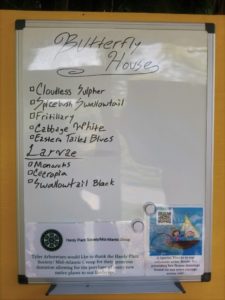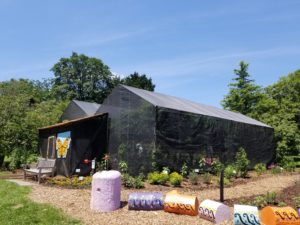I eagerly accepted the position as the Butterfly House Intern here at the John J. Tyler Arboretum in early March 2021, during the weeks when daylight began to extend its arms and the earth awakened from its cold sleep. My classes at Penn were being held virtually and a loose-fitting flannel and jeans were the outerwear. This was back when the soil surrounding the frame of the Butterfly House was hosting pale, lifeless flora, the cedar shingles were contorted under years of abuse from the sun, moss positioned itself on each motionless surface, plywood split along its seams, and outworn plants encompassed them all. I was made aware of the extensive task list time and time again, yet I remained in a state of serenity. How could I not? I had finally achieved my goal of working for an organization that believed in informing the public of the ecological importance of the area where I grew up.

Virtual meetings and occasional in-person visits occurred early in the season as we continued to lay out our transformation plan, but that changed once my spring semester was over at the beginning of May. By this time, outside contractors had torn out the pre-existing plants and we were left to defend our soil from the onslaught of recurring weeds. A seemingly impossible task, we continued to work through by mechanical, rather than chemical, means. Each shift presented us with the age-old question of what a weed really was as each seed bestowed itself from the Earth. The invasive Mugwort (Artemisia vulgaris) continued to be pulled up from its rhizome, but others like New York Ironweed (Vernonia noveboracensis), Plumbago (Plumbago sp.), and Violets (Viola sororia) were given their own home in our garden under strict watch. None of this work could be done if not for the help from our dedicated team of volunteers who continue to do amazing work to this day.

One would imagine that the installation of our shade cloth in early May would aid in preventing weed seeds from sprouting, but as we intended to grow plants inside for the insects, we still needed to allow a sufficient amount of daylight into the space. This massive net is primarily installed each year to deter unwanted pests from entering from the outside, all the while providing the incoming insects with a safe habitat to live out their days. Only after installation were we permitted to situate our carefully selected plants throughout the Butterfly House, as they would no longer face trampling during the rigorous installation process. The first wave of plantings consisted of but was not limited to, Cardinal Flower (Lobelia cardinalis), Columbine (Aquilegia canadensis), Garden Phlox (Phlox paniculata ‘Jeana’ & P. paniculata ‘Laura’), and a myriad of Milkweed (Asclepias spp.). With our plants finding their new homes, it became less challenging to distinguish what would be pulled up and what should be left to live out its life. The few we were unable to identify were left to grow until their flowering stage to help with identification. Most of the time, plants of this type were pulled up, but it forced us to keep an open mind as we progressed. However, the weeds did not become manageable until a 3” layer of leaf mould was laid down throughout the site over a few weeks.
Much of our planting was done between mid-May and mid-June with a few plants filling in the gaps here and there after the initial plantings on May 14. We had plants arrive in 6-flats, 4.5” pots, 1 gallon, some grown from seed, and even one or two delivered in the mail. During the weeks of relentless heat and little rainfall, we were required to water the soil around the base of these juvenile plants each morning until they took to their new homes. Thanks to our protective volunteer crew, there were very few casualties throughout those few arduous weeks. All the while, detailed plant lists were composed according to their location in the surrounding pollinator garden or within the Butterfly House. As we were starting anew this year, I wanted to make sure we had all of our cards in order going forward. Every plant one sees across the garden is accounted for, including its scientific name, mature size, flower color, bloom time, planting date, nativity, and its insect interactions. With this, we can now track which plant performed best in relation to the others regarding their specific purpose in our garden.

In the final days leading up to our official opening in July, we continued our behind-the-scenes tasks of designing and refining plant signage, planning group tours throughout the summer, collecting insightful literature for guests to view, and most importantly, gathering eggs and caterpillars on host plants across the site. Each day I find myself learning something more about plants, insects, and what it takes to teach those who are or are not interested in the subjects presented to us in our localized habitat. Synonymous to a butterfly emerging from its pupal casing, watching the color palette of the bare Butterfly House gradually shift from the browns and beiges found in winter to the brightly lit Pantone #114s, #199s, and #266s brought on by anthocyanin, carotene, and xanthophyll pigments have been equally as rousing. Again, this excitement we all feel here would not be possible without our volunteer gardeners, painters, and entomologists, nor the donors (The Hardy Plant Society/ Mid-Atlantic Group) and Hort staff whose help is all greatly appreciated. By the time of the next Butterfly House write-up, we can begin to discuss, at last, what it is like to witness butterflies fluttering above and around our heads again, and the joy of those living in that moment. Until then…







